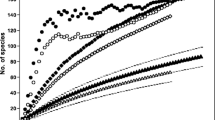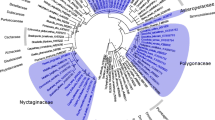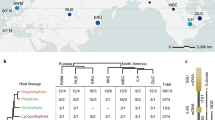Abstract
Host identity is among the most important factors in structuring ectomycorrhizal (ECM) fungal communities. Both host–fungal coevolution and host shifts can account for the observed host effect, but their relative significance in ECM fungal communities is not well understood. To investigate these two host-related mechanisms, we used relict forests of Pseudotsuga japonica, which is an endangered endemic species in Japan. As with other Asian Pseudotsuga species, P. japonica has been isolated from North American Pseudotsuga spp. since the Oligocene and has evolved independently as a warm-temperate species. We collected 100 soil samples from four major localities in which P. japonica was mixed with other conifers and broadleaf trees. ECM tips in the soil samples were subjected to molecular analyses to identify both ECM fungi and host species. While 136 ECM fungal species were identified in total, their communities were significantly different between host groups, confirming the existence of the host effect on ECM fungal communities. None of the 68 ECM fungal species found on P. japonica belonged to Pseudotsuga-specific lineages (e.g., Rhizopogon and Suillus subgroups) that are common in North America. Most of ECM fungi on P. japonica were shared with other host fungi or phylogenetically close to known ECM fungi on other hosts in Asia. These results suggest that after migrating, Pseudotsuga-specific fungal lineages may have become extinct in small isolated populations in Japan. Instead, most of the ECM fungal symbionts on P. japonica likely originated from host shifts in the region.



Similar content being viewed by others
References
Axelrod DI (1966) The Eocene Copper Basin flora of northeastern Nevada. University of California Publications in Geological Science 59:1–83
Cline ET, Ammirati JF, Edmonds RL (2005) Does proximity to mature trees influence ectomycorrhizal fungus communities of Douglas-fir seedlings? New Phytol 166(3):993–1009
Colwell RK, Chao A, Gotelli NJ, Lin SY, Mao CX, Chazdon RL, Longino JT (2012) Models and estimators linking individual-based and sample-based rarefaction, extrapolation and comparison of assemblages. J Plant Ecol 5(1):3–21
den Bakker HC, Zuccarello GC, Kuyper TW, Noordeloos ME (2004) Evolution and host specificity in the ectomycorrhizal genus Leccinum. New Phytol 163(1):201–215
Diedhiou AG, Selosse MA, Galiana A, Diabate M, Dreyfus B, Ba AM, de Faria SM, Bena G (2010) Multi-host ectomycorrhizal fungi are predominant in a Guinean tropical rainforest and shared between canopy trees and seedlings. Environ Microbiol 12(8):2219–2232
Douhan GW, Huryn KL, Douhan LI (2007) Significant diversity and potential problems associated with inferring population structure within the Cenococcum geophilum species complex. Mycologia 99(6):812–819
Eckert AJ, Hall BD (2006) Phylogeny, historical biogeography, and patterns of diversification for Pinus (Pinaceae): phylogenetic tests of fossil-based hypotheses. Mol Phylogenet Evol 40(1):166–182
Farjon A (1990) Pinaceae: drawings and descriptions of the genera Abies, Cedrus, Pseudolarix, Keteleeria, Nothotsuga, Tsuga, Cathaya, Pseudotsuga, Larix and Picea. Koeltz Scientific, Königstein, Germany
Gardes M, Bruns TD (1993) ITS primers with enhanced specificity for basidiomycetes—application to the identification of mycorrhizae and rusts. Mol Ecol 2(2):113–118
Gernandt DS, Liston A (1999) Internal transcribed spacer region evolution in Larix and Pseudotsuga (Pinaceae). Am J Bot 86(5):711–723
Grubisha LC, Trappe JM, Molina R, Spatafora JW (2002) Biology of the ectomycorrhizal genus Rhizopogon. VI. Re-examination of infrageneric relationships inferred from phylogenetic analyses of ITS sequences. Mycologia 94(4):607–619
Hermann RK (1985) The genus Pseudotsuga: ancestral history and past distribution. Forest Research Laboratory Corvallis, Oregon
Hirose D, Shirouzu T, Tokumasu S (2010) Host range and potential distribution of ectomycorrhizal basidiomycete Suillus pictus in Japan. Fungal Ecol 3(3):255–260
Horton TR, Bruns TD (1998) Multiple-host fungi are the most frequent and abundant ectomycorrhizal types in a mixed stand of Douglas-fir (Pseudotsuga menziesii) and Bishop pine (Pinus muricata). New Phytol 139:331–339
Horton TR, Bruns TD (2001) The molecular revolution in ectomycorrhizal ecology: peeking into the black-box. Mol Ecol 10(8):1855–1871
Horton TR, Molina R, Hood K (2005) Douglas-fir ectomycorrhizae in 40- and 400-year-old stands: mycobiont availability to late successional western hemlock. Mycorrhiza 15(6):393–403
Hosaka K, Castellano MA, Spatafora JW (2008) Biogeography of Hysterangiales (Phallomycetidae, Basidiomycota). Mycol Res 112:448–462
Ishida TA, Nara K, Hogetsu T (2007) Host effects on ectomycorrhizal fungal communities: insight from eight host species in mixed conifer-broadleaf forests. New Phytol 174(2):430–440
Jones MD, Twieg BD, Durall DM, Berch SM (2008) Location relative to a retention patch affects the ECM fungal community more than patch size in the first season after timber harvesting on Vancouver Island, British Columbia. For Ecol Manag 255(3–4):1342–1352
Kassai S, Saito M (2010) Distribution and suitable site of Pseudotsuga japonica in Mie prefecture (in Japanese). Chubu for res 57:55–56
Kennedy PG, Izzo AD, Bruns TD (2003) There is high potential for the formation of common mycorrhizal networks between understorey and canopy trees in a mixed evergreen forest. J Ecol 91(6):1071–1080
Kennedy PG, Garibay-Orijel R, Higgins LM, Angeles-Arguiz R (2011) Ectomycorrhizal fungi in Mexican Alnus forests support the host co-migration hypothesis and continental-scale patterns in phylogeography. Mycorrhiza 21(6):559–568
Kinoshita A, Sasaki H, Nara K (2011) Phylogeny and diversity of Japanese truffles (Tuber spp.) inferred from sequences of four nuclear loci. Mycologia 103(4):779–794
Kretzer A, Li YN, Szaro T, Bruns TD (1996) Internal transcribed spacer sequences from 38 recognized species of Suillus sensu lato: phylogenetic and taxonomic implications. Mycologia 88(5):776–785
Lang C, Seven J, Polle A (2011) Host preferences and differential contributions of deciduous tree species shape mycorrhizal species richness in a mixed Central European forest. Mycorrhiza 21(4):297–308
Luoma DL, Stockdale CA, Molina R, Eberhart JL (2006) The spatial influence of Pseudotsuga menziesii retention trees on ectomycorrhiza diversity. Can J For Res-Rev Can Rech Forestiere 36(10):2561–2573
Matheny PB, Aime MC, Bougher NL, Buyck B, Desjardin DE, Horak E, Kropp BR, Lodge DJ, Soytong K, Trappe JM, Hibbett DS (2009) Out of the Palaeotropics? Historical biogeography and diversification of the cosmopolitan ectomycorrhizal mushroom family Inocybaceae. J Biogeogr 36(4):577–592
McCune B, Mefford, M.J. (2006) PC-ORD. Multivariate analysis of ecological data, version 5. MjM Software, Gleneden Beach
Miki S (1957) Pinaceae of Japan, with special reference to its remains. J Inst Polytech, Osaka City Univ 8:221–272, Ser D
Molina R, Massicotte H, Trappe JM (1992) Specificity phenomena in mycorrhizal symbiosis: community-ecological consequences and practical implications. Mycorrhizal functioning: an integrated plant-fungal process. Chapman and Hall, London
Morris MH, Perez-Perez MA, Smith ME, Bledsoe CS (2009) Influence of host species on ectomycorrhizal communities associated with two co-occurring oaks (Quercus spp.) in a tropical cloud forest. FEMS Microbiol Ecol 69(2):274–287
Nara K, Nakaya H, Wu BY, Zhou ZH, Hogetsu T (2003) Underground primary succession of ectomycorrhizal fungi in a volcanic desert on Mount Fuji. New Phytol 159(3):743–756
Richard F, Millot S, Gardes M, Selosse MA (2005) Diversity and specificity of ectomycorrhizal fungi retrieved from an old-growth Mediterranean forest dominated by Quercus ilex. New Phytol 166(3):1011–1023
Rochet J, Moreau PA, Manzi S, Gardes M (2011) Comparative phylogenies and host specialization in the alder ectomycorrhizal fungi Alnicola, Alpova and Lactarius (Basidiomycota) in Europe. BMC Evol Biol 11:40
Sato H, Yumoto T, Murakami N (2007) Cryptic species and host specificity in the ectomycorrhizal genus Strobilomyces (Strobilomycetaceae). Am J Bot 94(10):1630–1641
Schorn HE (1994) A preliminary discussion of fossil larches (Larix, Pinaceae) from the Arctic. Quat Int 22(23):173–183
Smith ME, Douhan GW, Fremier AK, Rizzo DM (2009) Are true multihost fungi the exception or the rule? Dominant ectomycorrhizal fungi on Pinus sabiniana differ from those on co-occurring Quercus species. New Phytol 182(2):295–299
Strauss SH, Doerksen AH, Byrne JR (1990) Evolutionary relationships of Doughlas-fir and its relatives (genus Pseudotsuga) from DNA restriction fragment analysis. Can J Bot 68:1502–1510
Tamura K, Peterson D, Peterson N, Stecher G, Nei M, Kumar S (2011) MEGA5: molecular evolutionary genetics analysis using maximum likelihood, evolutionary distance, and maximum parsimony methods. Mol Biol Evol 28(10):2731–2739
Taylor DL, Bruns TD (1999) Community structure of ectomycorrhizal fungi in a Pinus muricata forest: minimal overlap between the mature forest and resistant propagule communities. Mol Ecol 8(11):1837–1850
Tedersoo L, Jairus T, Horton BM, Abarenkov K, Suvi T, Saar I, Koljalg U (2008) Strong host preference of ectomycorrhizal fungi in a Tasmanian wet sclerophyll forest as revealed by DNA barcoding and taxon-specific primers. New Phytol 180(2):479–490
Tedersoo L, Suvi T, Jairus T, Ostonen I, Polme S (2009) Revisiting ectomycorrhizal fungi of the genus Alnus: differential host specificity, diversity and determinants of the fungal community. New Phytol 182(3):727–735
Tedersoo L, May TW, Smith ME (2010) Ectomycorrhizal lifestyle in fungi: global diversity, distribution, and evolution of phylogenetic lineages. Mycorrhiza 20(4):217–263
Tedersoo L, Bahram M, Toots M, Diedhiou AG, Henkel TW, Kjoller R, Morris MH, Nara K, Nouhra E, Peay KG, Polme S, Ryberg M, Smith ME, Koljalg U (2012) Towards global patterns in the diversity and community structure of ectomycorrhizal fungi. Mol Ecol 21(17):4160–4170
Twieg BD, Durall DM, Simard SW (2007) Ectomycorrhizal fungal succession in mixed temperate forests. New Phytol 176(2):437–447
Wang XQ, Tank DC, Sang T (2000) Phylogeny and divergence times in Pinaceae: evidence from three genomes. Mol Biol Evol 17(5):773–781
Wei XX, Yang ZY, Li Y, Wang XQ (2010) Molecular phylogeny and biogeography of Pseudotsuga (Pinaceae): insights into the floristic relationship between Taiwan and its adjacent areas. Mol Phylogenet Evol 55(3):776–785
Yabe A (2011) Pseudotsuga tanaii Huzioka from the earliest Miocene Shichiku Flora of northeast Japan: systematics and ecological conditions. Paleontol Res 15(1):1–11
Yamamoto S (1992) Preliminary studies on the species composition, stand structure and regeneration characteristics of an old-growth Pseudotsuga japonica forest at the Sannoko on the Kii Peninsula, southwestern Japan. Jpn J Environ 34(1):50–58
Yamanaka T (1975) Ecology of Pseudotsuga japonica and other coniferous forests in eastern Shikoku (in Japanese with English summary). Mem Natl Sci Mus 8:119–136
Yatoh K (1958) Materials for the botanical study on the forest flora of the Kii Peninsula. Analysis and classification of the forest communities (in Japanese). Bull Fac Agr Mie Univ 18:105–167
Acknowledgments
We are grateful to members of Aki Forest Office, Mie Forest Office, and Mikio Mochizuki in Kawakita Forest Office, for their assistance in the field. This study was supported in part by a grant from Sumitomo Foundation (093014) and Grant-in-Aid for Scientific Research from Japan Society for the Promotion of Science (21658054 and 24780143).
Author information
Authors and Affiliations
Corresponding author
Electronic supplementary materials
Below is the link to the electronic supplementary material.
Fig. S1
Location of four study sites in Japan (PDF 103 kb)
Fig. S2
Rarefaction curves for ectomycorrhizal fungal richness on Abies firma, Tsuga sieboldii, and oak trees. Triangles represent observed species richness with 95 % confidence intervals (dotted lines). Jackknife2 and Chao2 minimal species richness estimates are also shown in circles and squares, respectively (PDF 65 kb)
Rights and permissions
About this article
Cite this article
Murata, M., Kinoshita, A. & Nara, K. Revisiting the host effect on ectomycorrhizal fungal communities: implications from host–fungal associations in relict Pseudotsuga japonica forests. Mycorrhiza 23, 641–653 (2013). https://doi.org/10.1007/s00572-013-0504-0
Received:
Accepted:
Published:
Issue Date:
DOI: https://doi.org/10.1007/s00572-013-0504-0




